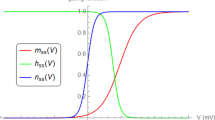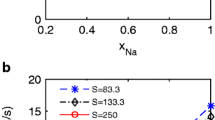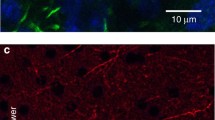Summary
The effect of pressure upon the delayed, K, voltage-clamp currents of giant axons from the squidLoligo vulgaris was studied in axons treated with 300nm TTX to block the early, Na, currents. The effect of TTX remained unaltered by pressure. The major change produced by pressures up to 62 MPa is a slowing down of the rising phase of the K currents by a time scaling factor which depends on pressure according to an apparent activation volume, ΔV∓, of 31 cm3/mole at 15°C; ΔV∓ increased to about 42 cm3/mole at 5°C.
Pressure slightly increased the magnitude, but did not produce any obvious major change in the voltage dependence, of the steady-state K conductance estimated from the current jump at the end of step depolarizations of small amplitude (to membrane potentials,E, ≦20 mV) and relatively short duration. At higher depolarizations, pressure produced a more substantial increase of the late membrane conductance, associated with an apparent enhancement of a slow component of the K conductance which could not be described within the framework of the Hodgkin-Huxley (HH)n 4 kinetic scheme.
The apparent ΔV∓ values that characterize the pressure dependence of the early component of the K conductance are very close to those that describe the effect of pressure on Na activation kinetics, and it is conceivable that they are related to activation volumes involved in the isomerization of the normal K channels. The enhancement of the slow component of membrane conductance by pressure implies either a large increase in the conductance of the ionic channels that are responsible for it or a strong relative hastening of their turn-on kinetics.
Similar content being viewed by others
References
Adelman, W.J., Jr., Palti, Y., Senft, J.P. 1973. Potassium ion accumulation in a periaxonal space and its effect on the measurement of membrane potassium ion conductance.J. Membrane Biol. 13:387–410
Cole, K.S., Moore, J.W. 1960. Potassium ion currents in the squid giant axon: Dynamic characteristic.Biophys. J. 1:1–14
Conti, F., Fioravanti, R., Segal, J.R., Stühmer, W. 1980. The effect of hydrostatic pressure on the voltage-clamp currents of the squid giant axon.In: Developments in Biophysical Research. A. Borsellino et al., editors. pp. 25–33. Plenum, New York-London
Conti, F., Fioravanti, R., Segal, J.R., Stühmer, W. 1982. Pressure dependence of the sodium currents of squid giant axons.69:23–34
Frankenhaueser, B., Hodgkin, A.L. 1956. The after-effects of impulses in the giant nerve fibres ofLoligo.J. Physiol. (London) 131:341–376
French, R.J., Wells, J.B. 1977. Sodium ions as blocking agents and charge carriers in the potassium channel of the squid giant axon.J. Gen. Physiol. 70:707–724
Harper, A.A., Macdonald, A.G., Wann, K.T. 1981. The action of high hydrostatic pressure on the membrane currents ofHelix neurones.J. Physiol. (London) 311:325–339
Henderson, J.V., Gilbert, D.L. 1975. Slowing of ionic currents in the voltage clamped squid axon by helium pressure.Nature (London) 258:351–352
Hodgkin, A.L., Huxley, A.F. 1952a. Currents carried by sodium and potassium ions through the membrane of the giant axon.J. Physiol. (London) 116:449–472
Hodgkin, A.L., Huxley, A.F. 1952b. A quantitative description of membrane current and its application to conduction and excitation in nerve.J. Physiol. (London) 117:500–554
Ilyin, V.I., Katina, I.E., Lonskii, A.V., Makovsky, V.S., Polishchuk, E.V. 1980. The Cole-Moore effect in nodal membrane of the frogRana ridibunda: Evidence for fast and slow potassium channels.J. Membrane Biol. 57:179–193
Johnson, F.J., Eyring, H., Polissar, M.J. 1954. The Kinetic Basis of Molecular Biology. Wiley, New York
Johnson, F.J., Eyring, H., Stover, B. 1974. The Theory of Rate Processes in Biology and Medicine. Wiley, New York
Macdonald, A.G. 1975. The effect of helium and of hydrogen at high pressure on the cell division ofTetrahymena pyriformis. W.J. Cell. Physiol. 85:511–528
Mastrangelo, C.J., Trudell, J.R., Cohen, E.N. 1978. Antagonism of membrane compression effects by high pressure gas mixtures in a phospholipid bilayer system.Life Sci. 22:239–244
Shrivastav, B.B., Parmentier, J.L., Bennett, P.B. 1979. Hydrostatic pressure increases the steady state conductance in the squid giant axon.Biophys. J. 25:15a
Author information
Authors and Affiliations
Rights and permissions
About this article
Cite this article
Conti, F., Fioravanti, R., Segal, J.R. et al. Pressure dependence of the potassium currents of squid giant axon. J. Membrain Biol. 69, 35–40 (1982). https://doi.org/10.1007/BF01871239
Received:
Revised:
Issue Date:
DOI: https://doi.org/10.1007/BF01871239




